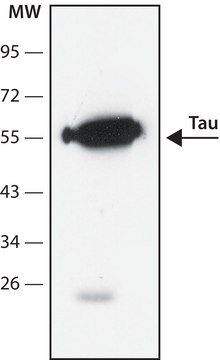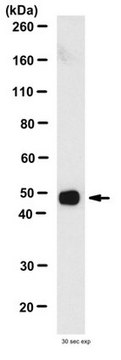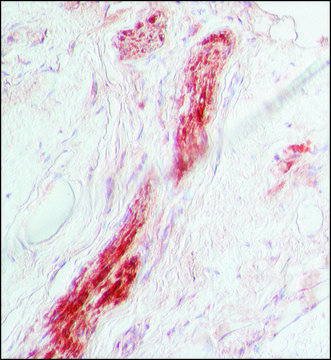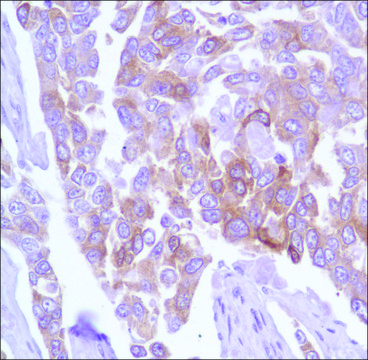推荐产品
生物来源
rabbit
抗体形式
serum
抗体产品类型
primary antibodies
克隆
polyclonal
种属反应性
human
种属反应性(根据同源性预测)
mouse (based on 100% sequence homology), rat (based on 100% sequence homology)
包装
antibody small pack of 25 μL
技术
electron microscopy: suitable
western blot: suitable
同位素/亚型
IgG
NCBI登记号
UniProt登记号
靶向翻译后修饰
unmodified
基因信息
human ... MAPT(4137)
mouse ... Mapt(17762)
rat ... Mapt(29477)
一般描述
Microtubule-associated protein tau (UniProt: P10636; also known as Neurofibrillary tangle protein, Paired helical filament-tau, PHF-tau) is encoded by the MAPT (also known as MAPTL, MTBT1, TAU) gene (Gene ID: 4137) in human. Microtubule-associated protein tau is shown to be expressed in neurons. It is mostly found in axons, in the cytosol, and in association with plasma membrane components. Nine isoforms of Tau have been described that are generated by alternative splicing. Tau proteins promote microtubule assembly and stability and may also be involved in the establishment and maintenance of neuronal polarity. The C-terminus binds axonal microtubules while the N-terminus binds neural plasma membrane components, thus serving as a linker protein between both. The short isoforms are reported to allow plasticity of the cytoskeleton whereas the longer isoforms may preferentially play a role in its stabilization. In Alzheimer disease (AD), the neuronal cytoskeleton in the brain is progressively disrupted and replaced by tangles of paired helical filaments (PHF) and straight filaments, mainly composed of hyperphosphorylated forms of Tau. In AD brain Tau accumulates in both the somatodendritic and axonal domains of neurons and it also accumulates in the soma as neurofibrillary tangles (NFTs). Tau oligomers are reported to be neurotoxic when applied extracellularly to cultured neuronal cells and can induce neurodegeneration and synaptic and mitochondrial dysfunction in vivo. It has been reported that most of the C-terminus of Tau (aa 243-406) in PHFs can be cleaved by trypsin, however the TauC4 region is highly resistant to trypsin action. (Ref.: Taniguchi Watanabe, S., et al. (2016). Acta Neuropathol. 131(2); 267-280; Ando K., et al. (2010). Biochem. Soc. Trans. 38(4); 1001-1005).
特异性
This rabbit polyclonal antibody specifically detects TauC4 region in human Tau protein.
免疫原
Epitope: unknown
KLH-conjugated linear peptide corresponding to 16 amino acids from the C-terminal half of human Microtubule-associated protein tau, isoform 8 (Tau-F).
应用
Anti-Tau (TauC4, 354-369), Cat. No. ABN2178, is a highly specific rabbit polyclonal antibody that targets TauC4 region of Tau and has been tested for use in Electron Microscopy and Western Blotting.
Research Category
Neuroscience
Neuroscience
Western Blotting Analysis: A representative lot detected Tau (TauC4, 354-369) in Western Blotting applications (Fitzpatrick, A.W.P., et. al. (2017) Nature. 547(7662):185-190; Taniguchi-Watanabe, S., et. al. (2016). Acta Neuropathol. 131(2):267-280).
Electron Microscopy Analysis: A representative lot detected Tau (TauC4, 354-369) in Immunogold negative-stain Electron Microscopy applications (Fitzpatrick, A.W.P., et. al. (2017) Nature. 547(7662):185-190).
Electron Microscopy Analysis: A representative lot detected Tau (TauC4, 354-369) in Immunogold negative-stain Electron Microscopy applications (Fitzpatrick, A.W.P., et. al. (2017) Nature. 547(7662):185-190).
质量
Evaluated by Western Blotting in Recombinant full-length 4-repeat (4R) tau (human 4R1N).
Western Blotting Analysis: A 1:2,000 dilution of this antibody detected TauC4 region in full length recombinant human tau (human 4R1N).
Western Blotting Analysis: A 1:2,000 dilution of this antibody detected TauC4 region in full length recombinant human tau (human 4R1N).
目标描述
~55 kDa observed; 45.85 kDa calculated.
外形
Unpurified
Rabbit polyclonal antiserum with 0.1% sodium azide.
储存及稳定性
Stable for 1 year at -20°C from date of receipt. Handling Recommendations: Upon receipt and prior to removing the cap, centrifuge the vial and gently mix the solution. Aliquot into microcentrifuge tubes and store at -20°C. Avoid repeated freeze/thaw cycles, which may damage IgG and affect product performance.
其他说明
Concentration: Please refer to lot specific datasheet.
免责声明
Unless otherwise stated in our catalog or other company documentation accompanying the product(s), our products are intended for research use only and are not to be used for any other purpose, which includes but is not limited to, unauthorized commercial uses, in vitro diagnostic uses, ex vivo or in vivo therapeutic uses or any type of consumption or application to humans or animals.
未找到合适的产品?
试试我们的产品选型工具.
法规信息
新产品
Ujjayini Ghosh et al.
Acta neuropathologica communications, 12(1), 94-94 (2024-06-13)
Down syndrome (DS) is a common genetic condition caused by trisomy of chromosome 21. Among their complex clinical features, including musculoskeletal, neurological, and cardiovascular disabilities, individuals with DS have an increased risk of developing progressive dementia and early-onset Alzheimer's disease
我们的科学家团队拥有各种研究领域经验,包括生命科学、材料科学、化学合成、色谱、分析及许多其他领域.
联系技术服务部门




